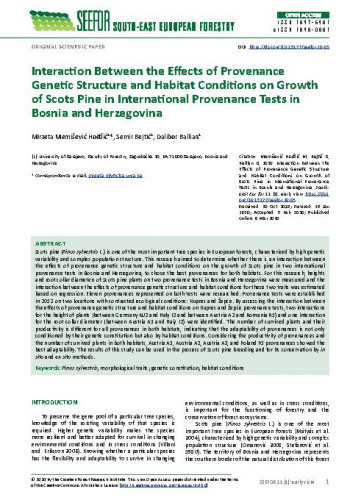Scots pine (Pinus sylvestris L.) is one of the most important tree species in European forests, characterized by high genetic variability and complex population structure. This research aimed to determine whether there is an interaction between the effects of provenance genetic structure and habitat conditions on the growth of Scots pine in two international provenance tests in Bosnia and Herzegovina, to chose the best provenances for both habitats. For this research, heights and root collar diameters of Scots pine plants on two provenance tests in Bosnia and Herzegovina were measured and the interaction between the effects of provenance genetic structure and habitat conditions for these two traits was estimated based on regression. Eleven provenances represented on both tests were researched. Provenance tests were established in 2012 on two locations with contrasted ecological conditions: Kupres and Žepče. By assessing the interaction between the effects of provenance genetic structure and habitat conditions on Kupres and Žepče provenance tests, two interactions for the height of plants (between Germany NJ2 and Italy I2 and between Austria A2 and Romania R1) and one interaction for the root collar diameter (between Austria A1 and Italy I2) were identified. The number of survived plants and their productivity is different for all provenances in both habitats, indicating that the adaptability of provenances is not only conditioned by their genetic constitution but also by habitat conditions. Considering the productivity of provenances and the number of survived plants in both habitats, Austria A1, Austria A2, Austria A3, and Poland P1 provenances showed the best adaptability. The results of this study can be used in the process of Scots pine breeding and for its conservation by in situ and ex-situ methods.
Sažetak

 South-east European forestry : SEEFOR : international scientific journal in field of forestry : 11,1(2020) / editor-in-chief Ivan Balenović.
South-east European forestry : SEEFOR : international scientific journal in field of forestry : 11,1(2020) / editor-in-chief Ivan Balenović.